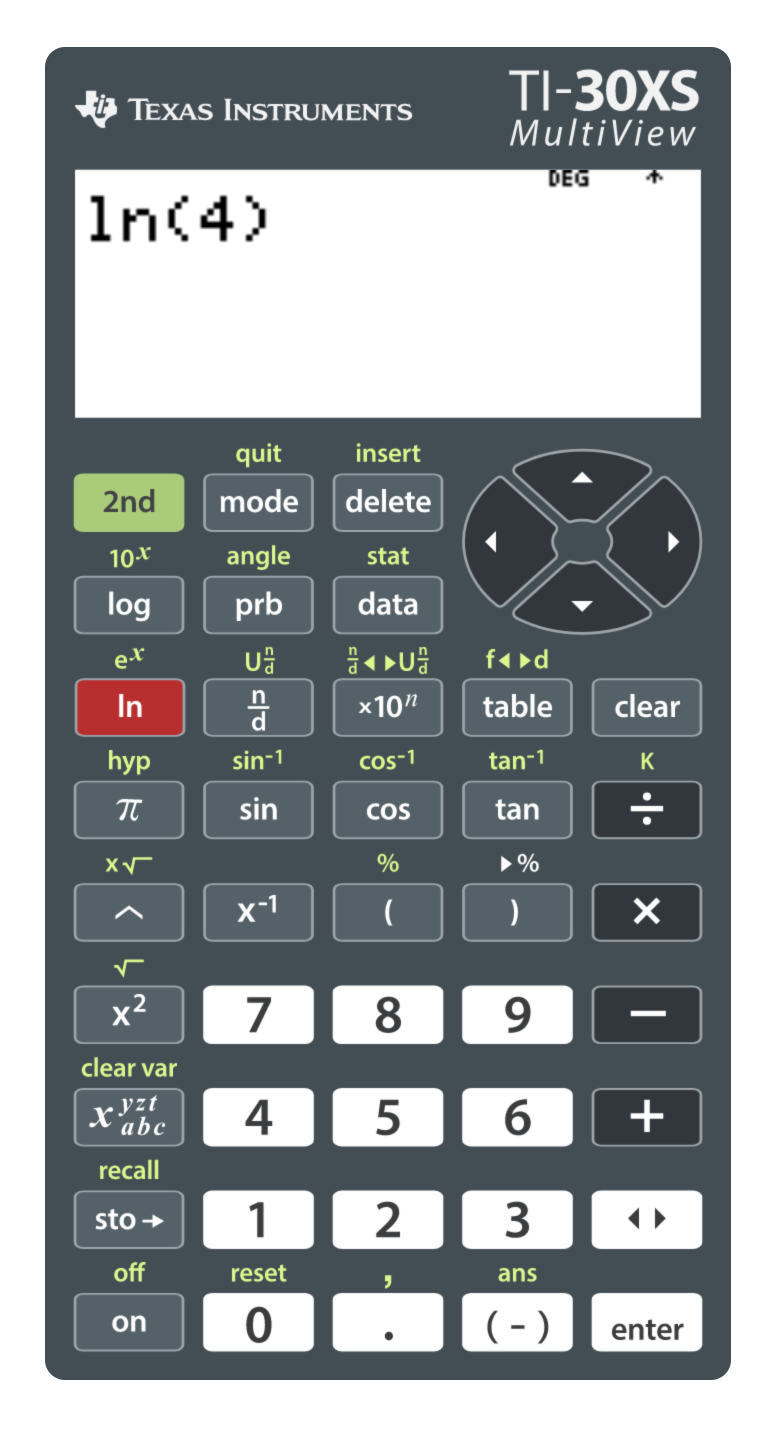“Boredom is an enemy of math” - me (Dave)
Precision to vision
So much of our focus on math centers on precision. Is the answer correct? Is it correct to a significant number of decimal places, etc.? Precision is important in math, and there are plenty of math resources that focus on math precision. The goal for Lazarus Math is for your math to come alive. Thus, our focus for Lazarus Math is vision, what you see, rather than precision, what you calculate.
We saw this concept in full force in the previous section where we journeyed through the story of the natural log function. Hopefully, that journey broadened your perspective or your “vision” of the natural log. For example, is an expression we can assign a real number to. Usually, the goal is to find that number. But that is not the only thing we can think about when we see this expression. We can envision as the area under a graph between and (see Figure 1).
Figure 1: Vision
So we can think of as something that has shape, curves, and area. It can utilize the part of our brain that absorbs pictures rather than facts. As we view this area, it gives a sense of direction, or at least magnitude, because we can observe that the area becomes smaller as we travel left to right. This leads to the observation that the new area we add to the sum will be smaller as we increase our input value . This vision is so much more than just knowing the steps we need to execute or which buttons to push on our calculator (see Figure 2).

Figure 2. Precision
For me, thinking about the natural log as the area under the graph of is a treasure that enriches my math world. To be honest, though, it is only a recent “treasure.” I had learned of this “fact” while studying calculus decades before when I was in school. But the significance of this “fact” had escaped me until I started writing Lazarus Math and gave it more thought. Previously, I only considered how to use this formula and thus focused on precision, but I certainly did not have vision. I did not take time to appreciate the value of a picture.
Even though this perspective of the natural log as an area under a curve is a new treasure to me, it is certainly an old treasure that has been known since the 17th century. In reality, it is almost collecting dust as it competes with the calculator key and its lightning-fast calculating capability. But as I reflected on the natural log function for Lazarus Math, not only did I get a better picture of this function, but I stumbled on an idea that was brand new to me. Of course, it also has been known for a long time in the math world, so it can be another old treasure that we will dust off and examine. Here is the story I uncovered when thinking about the natural log function as an area under a curve.
Retrieving the harmonic series area
To get the full story, let’s retrace some steps and compare the area from the harmonic series to the area under the graph of .
Figure 3. Revisiting two area graphs
Let’s keep the graph of in place but, in Figure 3, we shift the rectangles one unit to the right. When we make that small and subtle shift, we produce the graph in Figure 4.
Figure 4. Shift the harmonic series to the right
As a result of this change, we include the entire harmonic series, which starts with the first term 1. Then the area of the rectangles which represent the full harmonic series is greater than the area under the graph of .
In summary, we have two areas that are both infinite, where the downward staircase function is always greater than or equal to . Notice this is similar to what we did before, but now we join the top left side of the rectangles to intersect the graph of rather than the top right side. That leads us to an interesting question.
Even though the area for the rectangles is infinite and the area under the graph of starting at is infinite, can we calculate the difference between the two areas? Notice this question, another somewhat bold question, is asking for the difference between two infinite areas. Figure 5 is a graph where the shaded region represents the difference between these two infinite areas.
Figure 5. The difference between two infinite areas
Notice each region began as a rectangle and is reduced by the area below a curve. We know there are an infinite number of these regions and each region has a positive area. It may be interesting to just consider the area in one of these rectangles. It certainly seems like a difficult problem. But let’s throw caution to the wind and bravely consider calculating the total area of this infinite number of curved regions.
The Euler-Mascheroni constant
A first step may be to ask if this area is finite since we are summing an infinite number of positive areas. Long story short, we can celebrate the fact that the area does escape the black hole of infinity and arrives at something solid. It’s another special number, which means we reserve a name for it. This time the name we give it is the Greek letter gamma, . But the constant has another name more closely connected to its founders. This number is also called the Euler-Mascheroni constant.
Remember Leonhard Euler was the guy who named the number 2.718 the letter . This isn’t our last Euler story as we won’t be able to avoid stories about him in Lazarus Math. Euler was truly a remarkable mathematician who seemed to have his hand in many interesting math stories. Even though this constant bears his name, surprisingly, it is relatively unknown in the math world.
Uncovering the constant
Let’s take a moment and grasp what this number represents. The Euler-Mascheroni number is a single real number, like 1.23. In other words, we can cut a string so that its length is exactly this constant. Notice we once again witness the puzzling concept that we have an infinite process that produces an infinite number of shapes, each with a positive area. Then, when we somehow sum the total area for these infinite shapes, we land on or merge to a single number. What is this constant? The Euler-Mascheroni number written to the first 5 decimal places is 0.57722. Sorry, our result is not connected to π this time. But we do know it is connected to . We know it is connected to because the bottom curve which serves as a floor to the area is connected to the natural log function, which is the log to base .
What else do we know about this number? Math people have also determined that this number is irrational, which means the digits continue forever and never repeat a pattern. Perhaps knowing this is an irrational number actually makes sense. Even though we can cut a string that has this exact length, if we write this number in decimal format, we will forever be writing digits. Likewise, if we add areas for each rectangular part, we are adding more area to the total, so the sum of the areas continues to increase.
So, as we look under the hood of the Euler-Mascheroni number, we discover at least two important concepts that are bigger than the specifics of this number.
When infinity has a limit
The first thing we are discovering is both of these infinite processes, summing areas and writing digits, converge to an exact number. You may be skeptical as to how we can cut a string with an exact length equal to this number. Remember we are in the math world, not the real world. Sure, we likely cannot make this cut in the real world. But we cannot make a cut of length 1 in the real world either. In other words, we cannot draw a line segment that is exactly 1 inch. Pencil and paper cannot be that precise. How do we know if it is exactly 1 inch or 1.00000001 inch? Again, we don’t know. So we must approach this story strictly from the math world, not the real world.
In the math world, we can make a cut of exactly 1 and then form a square with each side length exactly 1. Then when we measure the length of the diagonal, it is exactly . Remember is an irrational number that has digits that repeat forever. Yet, we can produce a segment with this exact length. So this distance is exact even if the number written in decimal format never will be. All irrational numbers share this seemingly paradoxical property. The number is exact, the distance is exact. But we cannot express this exact number using decimals. So embedded within irrational numbers is this infinite process, even though this infinite process arrives at something exact.
We witnessed this concept in our Lazarus Math story of cutting a pizza and rearranging it to form a rectangle. The process was not complete if we made a finite number of cuts. But, once we let the process continue to infinity, we rested on a perfect rectangle and this perfect rectangle allowed us to calculate the exact area of the circle. If the radius is 1, then the area is simply , which is an irrational number
Isn’t this just fascinating? This process though is not limited to irrational numbers. If we cut a string that has length 1 into 3 equal parts, then the length of each part is . If we choose to write this distance in decimal format, we would write to 5 decimal places. Of course, we can write more numbers to achieve greater precision, and each digit will be 3. But we can never write the complete number in decimal format if we remain in the finite world. It’s only when we allow ourselves to enter into the infinite world, where we imagine the 3’s concatenated forever, that we arrive at the precise value for the number .
So what we are saying is that when we allow things to continue without end, we actually arrive at something specific and exact. As we have seen, this concept is now a natural way of thinking in math.
There may not be an easy way to completely be comfortable with this paradox. But perhaps one way to think of it is that the number is exact, but the process of expressing the number in a decimal format may not always be exact. So the problem is not with the number. The number is specific and clear. But what may not be clear is when we express this number using a decimal format.
The summary of our first discovery is an infinite process can result in something specific and exact.
Representing the world with numbers
The second idea we want to wrestle with is using real numbers to express things we visualize. For example, a line segment is just that: a line segment. But we have arrived at a process where we believe that we can assign a number to the length of the segment. We may get the impression that this is not an idea. For example, if a segment has a length of 1 inch, we just think that there is no creative work in this process. We can use our ruler and verify the segment is one inch long.
But someone defined the unit of an inch just like someone defined the unit of a meter and all other units we have. Try to remove the concept of all units and consider the idea connecting the length of the segment to a real number. Notice it is this decision to pair a segment to a number that caused us to create an entirely new set of numbers: the irrational numbers. We’ve heard the expression: Necessity is the mother of invention. Because we decided to connect distance measurement to numbers, we had to create in order to measure this distance.
We see this concept all the time in the physical world. When I was in college, we had phones but we certainly did not have smartphones. We created smartphones because we wanted to expand what a regular phone could do. By the time my grandkids were born, nearly every adult owned a smartphone. Thus, in their mind, a smartphone wasn’t invented but always existed. The same thing is true for irrational numbers. This may be more difficult to grasp because it’s been a long time since we created the idea of an irrational number and it is a concept, not a physical object. But we brought these numbers into the world so that our numbers will be “smarter”.
So we decided to connect a distance measurement to a real number. Once we opened the door to distance and one dimension, there was no reason to stop there. The natural next step is to move to the next dimension, two dimensions, and assign an area to a number as well. This real number is in the context of a squared area. The only change needed in assigning an area to the number 1 is to think of 1 as the area of a square that has a length of 1 for each side. Because we connect real numbers to area, we can say a square with area 1 has the same area as a rectangle with sides 2 and 0.5 since the area for this rectangle is also 1, which means it is a square unit.
Expanding the use of real number to two dimensions has an important implication. If we believe there is only one set of real numbers, then when we identify a property of real numbers using area, this property is always true for real numbers and thus will also be true when we connect real numbers to one dimension.
When all is said and done, what is happening is we are taking the world full of dimensions, whether it be the real world or our math world, and we are representing that world with numbers, specifically the real numbers. In the process, we believe the real numbers and all their properties remain consistent as we jump from dimension to dimension. If we have an area of 1 unit and an area of 2 units, then the total area will be 3 units. If we have 5 soccer balls each with a volume of 1, the total volume of all the soccer balls is 5. Likewise, if we triple the number of soccer balls we have, then the total volume is .
Perhaps this doesn’t seem noteworthy to you as we make these assumptions all the time. But this process does require a “leap of faith” and is one that people have chosen to make. Perhaps this “leap” is more evident when we are extending this principle to an infinite process with the Euler-Mascheroni number. We used an infinite process in the world of 2-dimensional area to uncover this real number. So this exercise we performed in calculating area is now new information we are associating with the real numbers. Once they are true for the real numbers, then we know we can use it if we move to a one- or three-dimensional case.
Some times these real numbers we identify as important in one dimension “carry over” as important in other dimensions. The classic example is , which is the ratio of the distance around a circle to the distance across the circle. This is a measurement in one-dimensional space and because of how we connect measurement in one-dimensional space to real numbers, now the real number is important. Notice we also find as important as we increase dimensions in order to calculating the area and volume of a circle. Distance, area, and volume are all quite different things in the real world. Because we associate the same real numbers to measuring all these dimensions, we can leverage what we learn in one dimension and apply it to two or more dimensions.
With these thoughts in mind, let me challenge you to reconsider how you think of . Perhaps you think of it as a number either in decimal format, such as 3.14, or as a fraction, such as , or perhaps as the Greek letter . None of these ideas are correct. What is ? It is the ratio of the distance around a circle to the distance across the circle. This ratio is constant for all circles. That is what this number is. Because we now assign this number to the real numbers and approximate it and also give it a letter, we mistakenly think that it is just a number.
Math people have been wrestling with this number from nearly the beginning of math thinking. But it wasn’t until Euler assigned this number to the Greek letter, that we labeled this as . This labeling has its benefit because it is convenient. But we have lost sight of the process. Before Euler, it was referred to in one way or another as the ratio of these two distances found in all circles. Notice how this changes our thinking.
We now memorize a formula that says the circumference of a circle is times the diameter, or times 2 times the radius. So, when we think about , we shouldn’t think of it as a number. Rather, think of it as a ratio of two distances that we can assign to a real number. Then, when we move to two dimensions and calculate the area for a circle, we have a choice. We can use either the original definition, the ratio of the circumference to the diameter, or the real number we assign to that ratio.
With these two discoveries in mind, let’s return to the focus of this section: the Euler-Mascheroni constant.
Calculating the Euler-Mascheroni constant
Now that we know what the constant is and have an appreciation for its development, let’s put pen to paper and retrieve the calculator to derive this number. Let’s begin by considering the area between and . We know the area under the staircase graph by summing the 4 rectangular areas. This area is 1 +++. The area under the graph of is . Remember is the solution for from the equation = 4. Thus, the area of the first 4 regions is the difference 1 + . This result for the first 4 terms is 0.69704. If we expand to 5 terms, then the difference is 0.67390, and if we expand to 6 terms, then the difference is 0.65824. Clearly, the difference is decreasing. But, is there a limit as to how small the difference will be? Yes, and that limit is the Euler-Mascheroni number.
If we wanted to write this in a formula for any positive integer , we would write
The result as approaches infinity is , or about 0.57722. Recall in the previous section, we identified that the sum of the harmonic series for the first 100 million terms is 18.9978964139. Then, if we subtract this result from , the difference is 0.57722 to 5 decimal-place precision, which matches the Euler-Mascheroni number rounded to 5 decimal places. Actually, we produce the first 8 digits of the Euler-Mascheroni number when we consider the first 100 million terms of the harmonic series.
Exploring the formula
At first glance, it is easy to interpret the Euler-Mascheroni constant as just a geeky constant. Sure, I will concede the geeky adjective for this number, but I find it fascinating. Of course, we can all generate some number by some obscure process. But that doesn’t make that number important. I consider the Euler-Mascheroni constant like a distant cousin to the number . They are related but in a distant way. Because is so important and shows up in so much math, it’s not surprising its distant cousin appears again in surprising places. Here are two examples where the constant appears seemingly out of nowhere.
First, consider the paradoxical function for the interval to infinity. The area from this function to the -axis is -1 times the constant. (Note that we consider the area below the -axis as “negative” area.) Recall that and . The function is interesting because it takes the ratio of the two operations that “undo” each other. How this area is connected to the area we calculated is a mystery to me.
A second example is the function . Remember the area under the graph of is the definition of the natural log function. Here, not only are we taking the natural log of but we do it twice. Then, the area between this graph and the -axis between and is the constant. To me, how this area is connected to our Euler-Mascheroni constant is another head-scratcher.
There are many other fascinating geeky relationships involving the constant, but let’s return to our original example of taking the difference between the harmonic series and the natural log.
One way to interpret the Euler-Mascheroni constant is that it is the difference between our discrete world and our continuous world. In this example, the discrete and continuous functions have the same value at each integer value for . But the discrete value is constant during that interval and then decreases suddenly, whereas the continuous is a smooth connection between the two endpoints.
I was not aware of the constant when I started to write Lazarus Math but stumbled across it in my research. When I reviewed the graph in Figure 5, an interesting question came to mind. Rather than evaluating the difference between this curved graph and taller rectangles, what if we evaluate the difference between this curved graph and shorter rectangles? In other words, let’s consider this area in Figure 6.
Figure 6. Identifying a new area under the curve.
Another area between infinities
Notice this is similar to the previous example where we calculated the area as the Euler-Mascheroni constant. This example is similar in that it compares the continuous to the discrete. The only difference here is we used the right endpoint to define the discrete value rather than the left endpoint. In other words, the value of the continuous curve is 1 at and 1/2 at . In the first example, we set the discrete area based on the value at the left endpoint, which is 1. This time, we set the discrete value at the right endpoint, which is 1/2 for the interval from 1 to 2.
Now, the area we’re interested in is the area from the continuous curve to the discrete lines since the continuous curve is never below the discrete lines.
Can we calculate this area? This appears to be another area that requires the magic of calculus. This is true if we calculate from first principles. However, if we’re clever, we don’t need to play our calculus mulligan again.
Notice what we get if we combine what we first calculated, which is the special constant , and this new area we want to calculate, which we will call . Note that is my invention, so don’t expect to find it somewhere else. What is the sum of + ? Figure 7 is a graph of this sum.
Figure 7. Two parts to the gamma constant
Notice we have nice rectangles, which simplifies calculating the area. But we have an infinite number of rectangles, so it will take some work. It will take a lot of work unless we stumble into the insight that each rectangle starts where the previous rectangle ends if you go from top to bottom. Thus, we can easily imagine stacking all the rectangles on top of each other. What do we get?
The top of the first rectangle starts at 1 and ends at . The top of the second rectangle starts at and ends at . This pattern continues as the height of the rectangles approach 0. That means the height of all the combined rectangles is 1 and the width of all the rectangles is also 1. Thus, the area of the sum of the rectangles is .
Therefore, the total area is 1. We already calculated , which is the part of each rectangle above the curve. That means the area below the curve is the total area minus the area above the curve. The total area is 1, and the area above the curve is . As a result, the area equals , which is about 0.423 and a little less than .
Finding insights like this makes math so much fun! Let’s keep this positive feeling going and lean on our intuition for more progress.
Hot Wheel® curves
Is there a reason, or an intuition, as to why is a little less than ?
If we draw a diagonal line from the top left corner of the rectangle to the bottom right corner of the rectangle, notice the curved line is below the dotted line, except at the endpoints. Thus, the area under the curve is a little less than the area above the curve. Some of you likely identified this result faster because the curve is concave up, like the inside of a bowl.
This "concave up" characteristic is similar to the Hot Wheels® track I used to play with as a kid. If you want the Hot Wheels® to go, then the track needs to slope down. However, if you want them to go smoothly, the slope needs a little “bow” shape that levels off. Observe in Figure 8, we have this Hot Wheels® type curve in every interval of the natural log function, which is one of the interesting features of this function. That means this Hot Wheels® type curve will always be lower than a straight line that connects the two endpoints. This is the opposite of an exponential curve which increases faster as we go farther to the right.
Figure 8. A curve that concave up.
Answering why is less
We can take this one step further. Since we know the diagonal line cuts the rectangle in half, the area above the dotted line is one half the total area of the rectangle. We identified the total area of all the rectangles is 1. Thus, the area from the dotted line to the top of the rectangles must be or 0.5. This gives us the intuition that would be a little more than 0.5 but not too much more because we know the sum of the rectangles is 1.
Isn’t that enlightening? Before, it seemed like the Euler-Mascheroni constant being about 0.58 was a random result. We took the difference between two infinite processes. We could have stated the result to be about 5.8, and we likely would not have an intuition the result is wrong. But we created a different perspective of this area as a subset to a series of rectangles that we identified as having a total area of 1. This gave us the intuition the constant should be less than 1. Then, we further identified the area was slightly more than half the area when we split it using a diagonal line. This refined our estimate further so that it is not only less than 1 but also slightly more than 0.5. Perhaps other people have these insights as well. These were insights I gathered from pondering over this number, so maybe these insights are only realized by Lazarus Math readers!
Let’s return to some previous research to refine our approach. Recall the estimate from the previous section for the area under the graph of from to . We estimated 1.46, but the correct answer was 1.39. Previously, I stated that later we would identify why our estimate was too high. Later is now so let’s answer why by examining what our estimate was actually doing.
In the previous section, we estimated the area below based on two extreme cases. The larger estimate used the left point on the graph to determine the height of the rectangle and the smaller estimate used the right point on the graph. Thus, the first interval could be considered a rectangle of height 1 or a rectangle of height 0.5. Remember we took an average of the two values. One way to view the average is to start with the region below 0.5 and then add half the region above 0.5. To create the half-region, we can draw a diagonal from the top left edge where the height is 1 and finish at the bottom right edge where the height is 0.5. This is the same as the dotted lines in the previous graph of Figure 8. Therefore, one way to illustrate our method of calculating the average of the two extremes is calculating the area under the dotted lines.
Given that perspective, we know our estimate will be too high because the graph of is always below the diagonal line that connects the curve at each integer value of . Since is always concave up, then it is always below than the diagonal lines except at the integer values of . This leads to the conclusion that the area below is always less than the average area. Because is always concave up, we could improve our estimate by using smaller intervals. This would create more rectangles, so the diagonal of each rectangle moves closer to as illustrated in Figure 9.
Figure 9. Understanding the gamma constant by refining the rectangles using smaller widths
Because always includes the entire region above the dotted diagonal plus a little more, then always contains a little less than half the area of each rectangle. Thus, will equal a little more than 0.5, and will equal a little less than 0.5.
Are you enjoying our journey of trying to make sense of the things we can count and the things we can measure? In one sense, we can consider calculating as a collision course between the two. We allowed these two rivals to go head to head. We noticed they both flashed us their infinite powers on their own. However, when we compared the two by taking their difference, we tamed these two beasts, and each left the black hole of the infinite and returned to something we can relate to: or its newfound friend, . No, we don’t know the exact value of these irrational numbers. We do know about the first 10 billion digits, so we’re off to a good start!
The long tail
Now that we understand and , we should ask one more question. What is the area of the graph below as depicted in Figure 10?
Figure 10. Considering the area below the shorter steps
We know when we started with the harmonic series, the sum is infinite. This is the area below the larger steps in Figure 10. Then, we dipped lower to our graph of and, even though we shaved quite a bit off the top, the series remained in the black hole of infinity. This is the area below the curve inbetween the two steps. Now, we’ve performed another “haircut” by removing what we calculated as . So does the remaining part of the graph equal some number?
Even though we removed 50% of the first rectangle and significant amounts of the other rectangles we are viewing, remember the total amount we removed from our sum is just 1. In other words, we only removed and from the area below the larger steps, and the sum of these two numbers is only 1. As a result, an infinite sum minus 1 remains infinite. What this illustrates is how much area is in this long “tail." This is clear in Figure 11 when we view the same graph for 100 intervals rather than 5.
Figure 11. The big picture of 1/x and the gamma constant
Our eyes focus on the first few examples, and we see major changes. However, the infinite area results because this graph only slowly approaches 0, and and do not remove much of the area in the tails.
Ruminating on irrationals
Before we quit, let’s take a moment and ruminate on the irrational numbers we’ve highlighted so far in Lazarus Math. The primary irrational numbers we’ve studied are and the Euler-Mascheroni constant. We know the digits for each of these numbers go on forever because that is a property of all irrational numbers. However, usually after a few decimal places, the digits are not significant, at least not significant for any practical application. But, since our focus is vision and not precision, let’s consider these insignificant digits.
You can consider any one of these irrational numbers. Isn’t it interesting that there is an exactness to these numbers that trail off forever. In other words, not only is there a one billionth digit, but that one billionth digit is precise. Depending on the number, we could actually identify that digit. Regardless of the situation where this irrational number is used, each digit is exact. So you can draw a circle of radius 10 or 15, but the area will always be the exact recipe of , and as we travel to the 100 billionth digit of , we will be more exact in our calculation of the area than before we considered that digit. Or we can measure the distance around a circle and divide it by the distance across a circle, and the result is some number that has an infinite number of digits. Isn’t that amazing? And we are so sure of this number, we get the exact same result regardless of the size of the circle.
As mentioned, math people have been studying for a long time. Not only did Euler give it the letter , but he also determined that it is irrational. Remember our new perspective. It is the ratio of the distance around a circle to the distance across the circle that is irrational. We just happen to assign this ratio a number and represent it with a letter.
Likewise, we may think of as 1.41421356. This is not the number even though it may be what appears on our calculator. Rather is the number that when multiplied by itself is 2. has an infinite number of decimal places. That means, if we “only” consider the first 1 trillion digits and take that number by itself, the result will not be exactly 2, and we are confident of that fact. But that doesn’t mean this number is not just some abstract idea. We get this number when we measure the diagonal of a square with length 1. So this number has a specific known distance. But we cannot state the number precisely using decimals.
We know so much of these irrational numbers and yet, we know so little.










